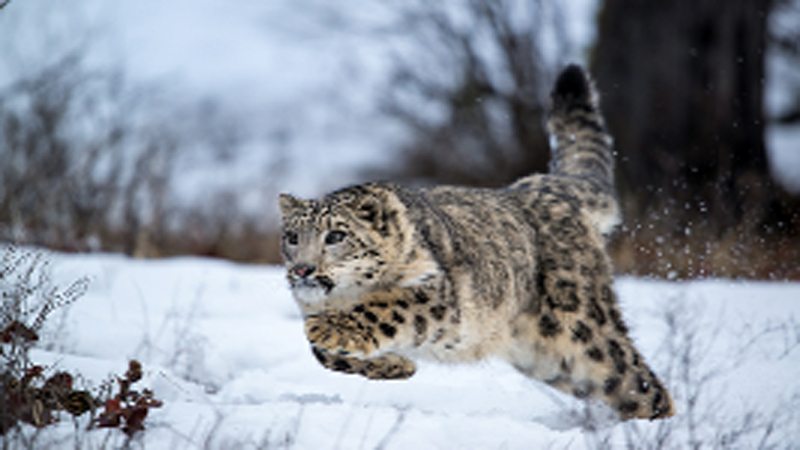That the Snow Leopard faces extinction ought to give us all cause for alarm. For this magnificent creature is king of the ecosystem, given his status as the leading predator when it comes to regulating wildlife population.
He faces threat both from the environment and mankind; including climate change, reduced prey and surges in human population. Yet above all is he hunted. His skin, after all, is known to sell for rather handsome amounts. And then his bones are prized by practitioners of traditional medicine. There are those, too, who profit from keeping him in captivity whether at the circus or at the zoo. And even when he is not being deliberately hunted down — he still remains under fire. With an ever increasing human population comes over consumption of pastures, thereby risking the Snow Leopard’s natural habitat. He is not even safe from men of the land. Shepherds facing financial constraints have been known to kill him in a bid to protect their herds. All of which has led the International Union for Conservation of Nature to declare the Snow Leopard an endangered species. This is supported by the World Wildlife Fund (WWF), which has found that populations have fallen by 20 percent over the last 16 years.
So, what is being done to ensure his survival against these odds? The Bishkek Declaration of 2013 on Conservation of the Snow Leopard named October 23 as International Snow Leopard Day. The latter is intended to raise awareness among the masses and has been signed by all 12 Snow Leopard range nations: Pakistan, India,Afghanistan, China, Russia, Bhutan, Kazakhstan, Kyrgyzstan, Mongolia,Nepal, Tajikistan and Uzbekistan. These have committed to protecting and securing 20 snow leopard landscapes by 2020. Moreover, Pakistan is well-placed to take the lead on these initiatives. The country’s minister for Climate Change, mushahidullah Khan,won a 12-strong unanimous vote to assume the chairmanship of the Global Snow Leopard and Ecosystem Protection (GSLEP) back in 2015. The latter comprises all snow leopard range nations as well as non-governmental and inter-governmental organisations, local communities and the private sector.
Pakistan is home to the world’s third largest snow leopard population. Yet in real terms there are only about 200 of these big cats said to living in the country’s mountainous northern areas; that is, across the 80,000 sq kilometres that stretch from Khyber Pakhtunkhwa (KP) to Gilgit Baltistan (GB), Azad Kashmir as well as Indian-held Kashmir. Sixty percent of these can be found in GB, the highest concentration anywhere in Pakistan.

Again, Pakistan proudly takes its place at the forefront of Snow Leopard Conservation. Last year Dr Muhammad Ali Nawaz won the prestigious Whitley Award in recognition of his work at the helm of the country’s Snow Leopard Trust. This programme partners the Snow Leopard Foundation, the Ministry of Climate Change, provincial wildlife departments as well as local communities. Dr Nawaz is also part of the Quaid-e-Azam University teaching faculty.
Be that as it may, now is not the time for Pakistan to show complacency. We should be looking to the future; towards establishing a permanent secretariat at the governmental level in order to develop long-term strategies to safeguard the few snow leopards we have left. Zoological departments at our universities should pay particular interest in facilitating students to conduct research on the impact of climate change on the Snow Leopard with a view to strategy-making. All findings should then be shared among the 12 Snow Leopard range countries in order to develop a regional conservation programme that also focuses on tracking progress on all fronts.
In addition, when it comes to international funding of wildlife conservation — a fixed tranche of this should be earmarked specifically for the Snow Leopard. Local wildlife departments in snow leopard landscapes should hire animal behavioural psychologists to inform their own experts as well as communities on the ground about the discernible nature of this big beautiful cat. This would help all concerned to respond to threats posed by the Snow Leopard without killing him. Towards this end, wildlife departments should also set aside a budget to pay compensation for any cattle killed.
The story of trophy hunting of the Markhor goat is a successful one here in Pakistan. Aggressive conservation efforts led to increased population of this noble, long-horned beast. Thus when such hunting efforts are conducted within a tightly controlled environment this can lead to increased incentives to conserve particular wildlife. Therefore the state should look at promoting more trophy hunting of the Snow Leopard, especially in areas like GB. Naturally, any illegal hunting should bring with it harsh punishment. Pakistan must also prioritise updating its current legislation on wildlife conservation in order to meet new international commitments and emerging needs. Separating Wildlife Protection and Conservation Policy at both the federal and provincial level is also a must.
The writer is based in Islamabad and works on environmental issues. She can be reached at zilehuma_1@hotmail.com
Published in Daily Times, October 24th 2017.
